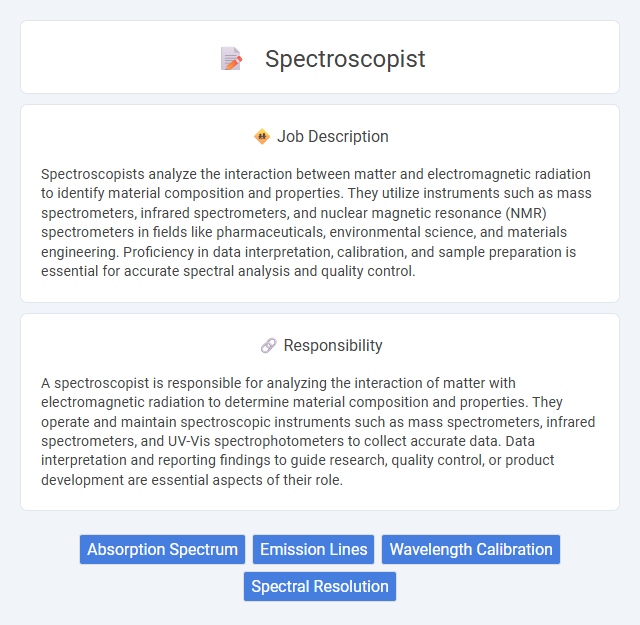
Spectroscopists analyze the interaction between matter and electromagnetic radiation to identify material composition and properties. They utilize instruments such as mass spectrometers, infrared spectrometers, and nuclear magnetic resonance (NMR) spectrometers in fields like pharmaceuticals, environmental science, and materials engineering. Proficiency in data interpretation, calibration, and sample preparation is essential for accurate spectral analysis and quality control.
Individuals with strong analytical skills and a keen attention to detail may find spectroscopist roles well-suited, as the job often involves interpreting complex data. Those comfortable with working in laboratory environments and handling sensitive instruments could likely adapt well to the physical and technical demands of the position. People who prefer routine or minimal variability might face challenges, given the dynamic nature of research and problem-solving involved in spectroscopy.
Qualification
A spectroscopist typically requires a bachelor's degree in chemistry, physics, or a related scientific field, with many positions favoring candidates holding a master's or Ph.D. Specialized training in spectroscopy techniques such as UV-Vis, IR, NMR, and mass spectrometry is essential. Proficiency in data analysis software and experience with laboratory instrumentation enhance a candidate's qualification profile significantly.
Responsibility
A spectroscopist is responsible for analyzing the interaction of matter with electromagnetic radiation to determine material composition and properties. They operate and maintain spectroscopic instruments such as mass spectrometers, infrared spectrometers, and UV-Vis spectrophotometers to collect accurate data. Data interpretation and reporting findings to guide research, quality control, or product development are essential aspects of their role.
Benefit
Spectroscopist roles likely offer significant benefits such as access to cutting-edge technology and opportunities for contributing to scientific advancements in fields like chemistry, physics, and materials science. The position may provide a competitive salary and benefits package, including healthcare, retirement plans, and professional development resources. Job stability and career growth potential seem probable due to the ongoing demand for spectroscopy expertise in research and industry.
Challenge
A spectroscopist often faces the challenge of accurately interpreting complex spectral data, which may involve distinguishing subtle variations in chemical compositions or physical properties. There is a probable need to adapt quickly to evolving technologies and methodologies in spectroscopy to maintain precision and reliability in results. The role likely demands strong problem-solving skills to address unexpected anomalies in spectra and optimize analytical techniques.
Career Advancement
Spectroscopists specializing in analytical techniques such as NMR, IR, and mass spectrometry can advance to lead roles in research and development, quality control, or pharmaceutical industries. Expertise in data interpretation and instrument calibration enhances opportunities to mentor junior scientists or manage laboratory operations. Continuing education and certifications in advanced spectroscopy methods significantly boost prospects for senior positions and high-impact projects.
Key Terms
Absorption Spectrum
A spectroscopist specializing in absorption spectrum analyzes how materials absorb light at different wavelengths to determine chemical composition and molecular structure. Precise measurement of absorption peaks enables identification of specific atoms or molecules and quantification of their concentration in samples. Expertise in instruments like UV-Vis spectrophotometers and infrared spectrometers is essential for accurate spectral data interpretation.
Emission Lines
Spectroscopists specializing in emission lines analyze the wavelengths of light emitted by excited atoms and molecules to identify the chemical composition of various materials. Mastery of tools such as spectrometers and knowledge of atomic emission spectra allows spectroscopists to detect elemental signatures in plasma, stars, or industrial samples. Accurate interpretation of emission line data is crucial in fields like astrophysics, environmental monitoring, and materials science for determining sample purity and physical conditions.
Wavelength Calibration
Wavelength calibration is a critical task for spectroscopists to ensure the accuracy and precision of spectral data, involving the use of known reference lines from calibration lamps or standards. Precise calibration enables correct identification of spectral features and reliable quantitative analysis across UV, visible, and infrared spectrums. Advanced techniques in wavelength calibration improve instrument performance, reduce measurement errors, and enhance reproducibility in scientific research and industrial applications.
Spectral Resolution
Spectroscopists specialize in analyzing the spectral resolution of various materials using advanced instruments like spectrometers and spectrophotometers to identify detailed molecular structures and compositions. High spectral resolution enables the detection of closely spaced spectral lines, crucial for applications in chemistry, physics, and environmental science. Mastery in optimizing spectral resolution enhances the accuracy of data interpretation in research and industrial quality control.
 kuljobs.com
kuljobs.com